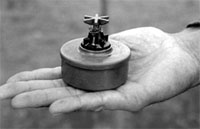This Day in History: October 30, 1997
Additional Date: October 30, 1997
South Africa announced that it had completed destroying its stock pile of anti-personnel mines. A total of 261 423 were destroyed, while 18 000 were retained for training purposes. 5 000 of the mines left were live mines and 13 000 were retained to be used for training in demining. Anti personnel mines are mine explosives designed to injure personnel or people rather than equipment. In the 1990s South Africa began to revise its policy on the use of landmines. For instance, in 1994 the former South African government announced a moratorium on the marketing, export and transit of all types of landmines in line with the UN General Assembly Resolution on landmines. In May 1996, the the use of antipersonnel mines was suspended, pending an evaluation of their use as a weapon.
In December 1996 the United Nations General Assembly adopted a resolution entitled "An international agreement to ban anti-personnel landmines". This resolution was supported by 155 countries including South Africa. This was followed by a Diplomatic Conference chaired by South Africa in Oslo Norway pushing for an international convention that would ensure a total ban on the manufacture and use Anti-Personnel landmines. On 19 February 1997 the South African cabinet resolved to prohibit with immediate effect the use, development, production and stockpiling of anti-personnel landmines. Furthermore, the cabinet resolved to destroy South Africa's existing stockpile of anti-personnel landmines.
On 18 September 1997 the Diplomatic Conference adopted the Convention on the Prohibition of the Use, Stockpiling, Production and Transfer of Anti-Personnel Mines and to encourage their destruction. The Convention was ratified by 81 States and signed by 133 States. South Africa began destroying its stockpile of anti personnel mines before signing the Convention in December 1997. Mozambique and Angola are two of Southern African countries most affected by landmines that were largely supplied by the apartheid government to the rebel movements they sponsored to destabilize the region. For instance, Angola has an estimated 80 000 people injured by landmines.
